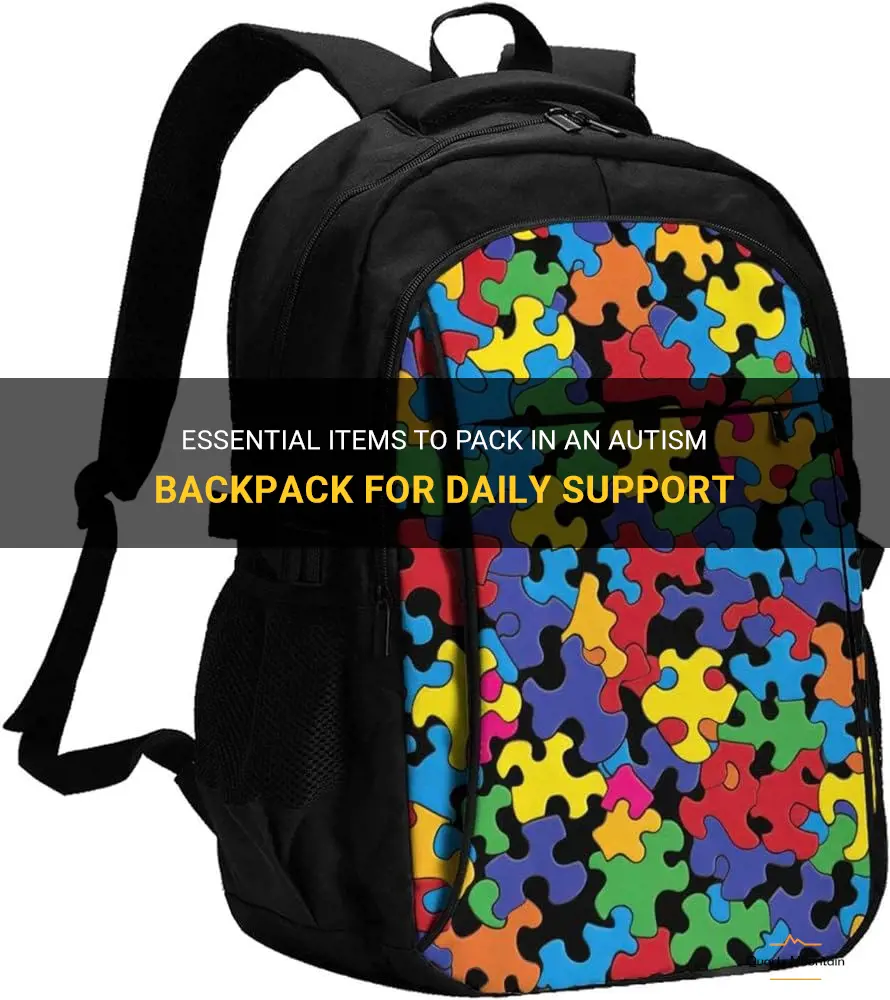
Packing for any outing can be a daunting task, especially when it comes to supporting a child with autism. Having the right items readily available can make a world of difference in providing comfort, reducing anxiety, and promoting independence. That's why an autism backpack filled with essential items becomes an invaluable companion for everyday adventures. In this guide, we will explore the must-have items to include in an autism backpack, ensuring that you and your loved one are fully prepared for any situation that may arise throughout the day.
| Characteristics | Values |
|---|---|
| Comfortable | Yes |
| Durable | Yes |
| Lightweight | Yes |
| Easy to clean | Yes |
| Water-resistant | Yes |
| Multiple pockets | Yes |
| Adjustable straps | Yes |
| Secure closures | Yes |
| Reflective | Optional |
| Sensory-friendly | Optional |
What You'll Learn
- What are the essential items to pack in an autism backpack for a child with sensory sensitivities?
- How can I customize a sensory kit for my child's autism backpack based on their individual needs?
- Are there any specific strategies or tools that should be included in an autism backpack to help with communication and social interaction?
- What should I consider when choosing a backpack for my child with autism?
- Are there any recommended resources or online stores where I can purchase pre-made autism backpacks or sensory kits?

What are the essential items to pack in an autism backpack for a child with sensory sensitivities?
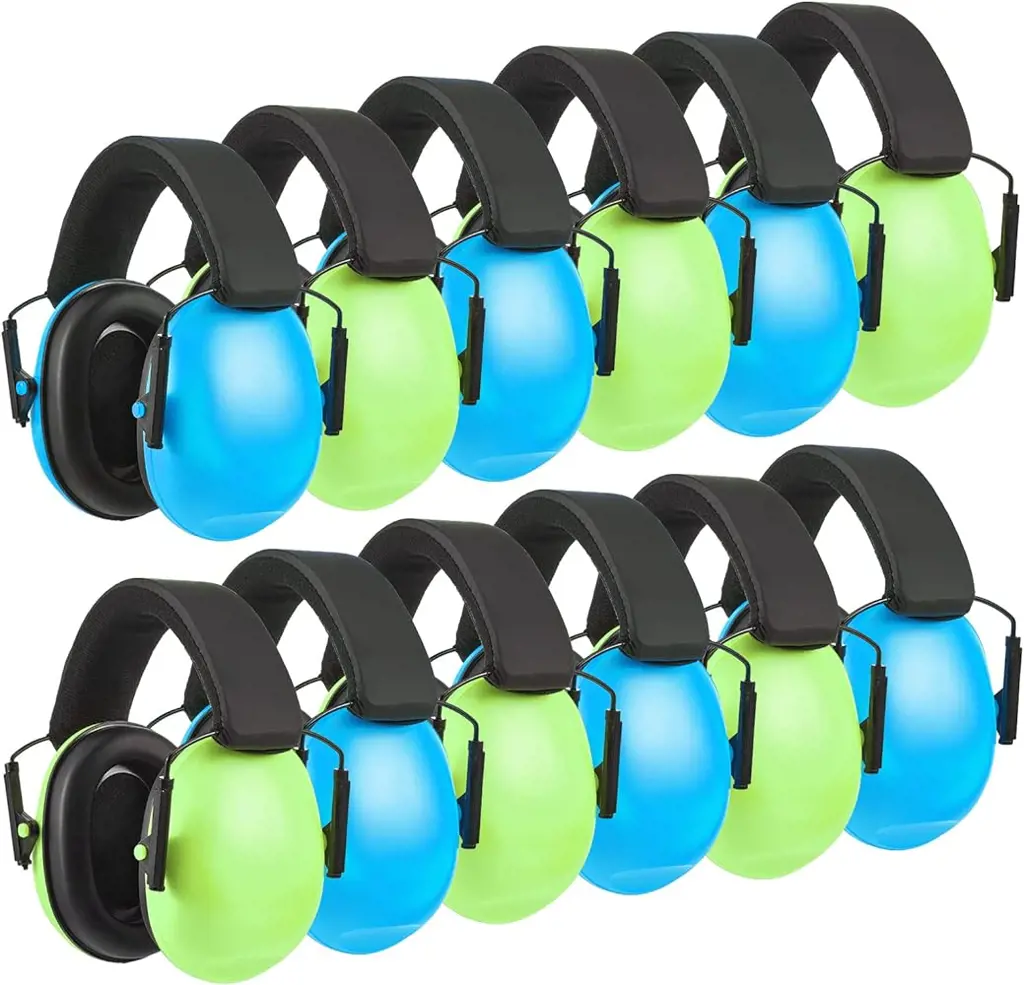
Children with autism often have sensory sensitivities that can make everyday experiences overwhelming and challenging. One way to help them navigate these situations is by having a sensory-friendly backpack filled with essential items that can provide comfort and support. Here are some items that are commonly included in an autism backpack for a child with sensory sensitivities:
- Weighted blanket or lap pad: Weighted items can provide a calming and grounding effect. The pressure from a weighted blanket or lap pad can help regulate sensory input and promote relaxation.
- Noise-cancelling headphones: Loud or unexpected noises can be distressing for children with sensory sensitivities. Noise-cancelling headphones can help block out or reduce the intensity of sounds, creating a more peaceful environment.
- Fidget toys: Fidget toys are small handheld items that can be manipulated or squeezed to provide sensory stimulation. They can help redirect restless energy, reduce anxiety, and improve focus.
- Chewable items: Many children with autism benefit from having chewable items to satisfy their oral sensory needs. Chewable necklaces, bracelets, or chewy tubes can provide a safe and appropriate outlet for chewing.
- Visual supports: Visual supports, such as a schedule or social stories, can help children with autism understand and navigate their environment. These supports can provide predictability and structure, reducing anxiety and promoting independence.
- Sensory snacks: Some children with autism may have specific dietary preferences or sensory aversions. Having sensory-friendly snacks on hand can help ensure that the child is getting proper nutrition and can be a helpful tool to redirect attention or provide comfort.
- Calming tools: Calming tools, such as stress balls or sensory bottles, can provide a tactile and visual distraction during stressful moments. These tools can help the child self-soothe and regulate their emotions.
- Communication tools: Depending on the child's communication abilities, including communication tools in the backpack can be essential. This can include picture cards, a communication app on a tablet, or a small whiteboard and marker.
When packing an autism backpack, it's important to consider the individual needs and preferences of the child. Some children may have specific items or strategies that work best for them. It can be helpful to involve the child in the process of selecting and personalizing their backpack, as this can provide a sense of ownership and empowerment.
In addition to the items in the backpack, it's important for parents and caregivers to be knowledgeable about the child's sensory triggers and to have strategies in place to help them manage sensory overload. This may include taking breaks in a quiet space, using deep pressure techniques, or engaging in calming activities.
Overall, an autism backpack filled with essential sensory items can be a valuable tool for children with sensory sensitivities. It can support their sensory needs, promote self-regulation, and enhance their overall well-being in various environments.
Essential Items to Pack for Your Trip to Vietnam
You may want to see also

How can I customize a sensory kit for my child's autism backpack based on their individual needs?
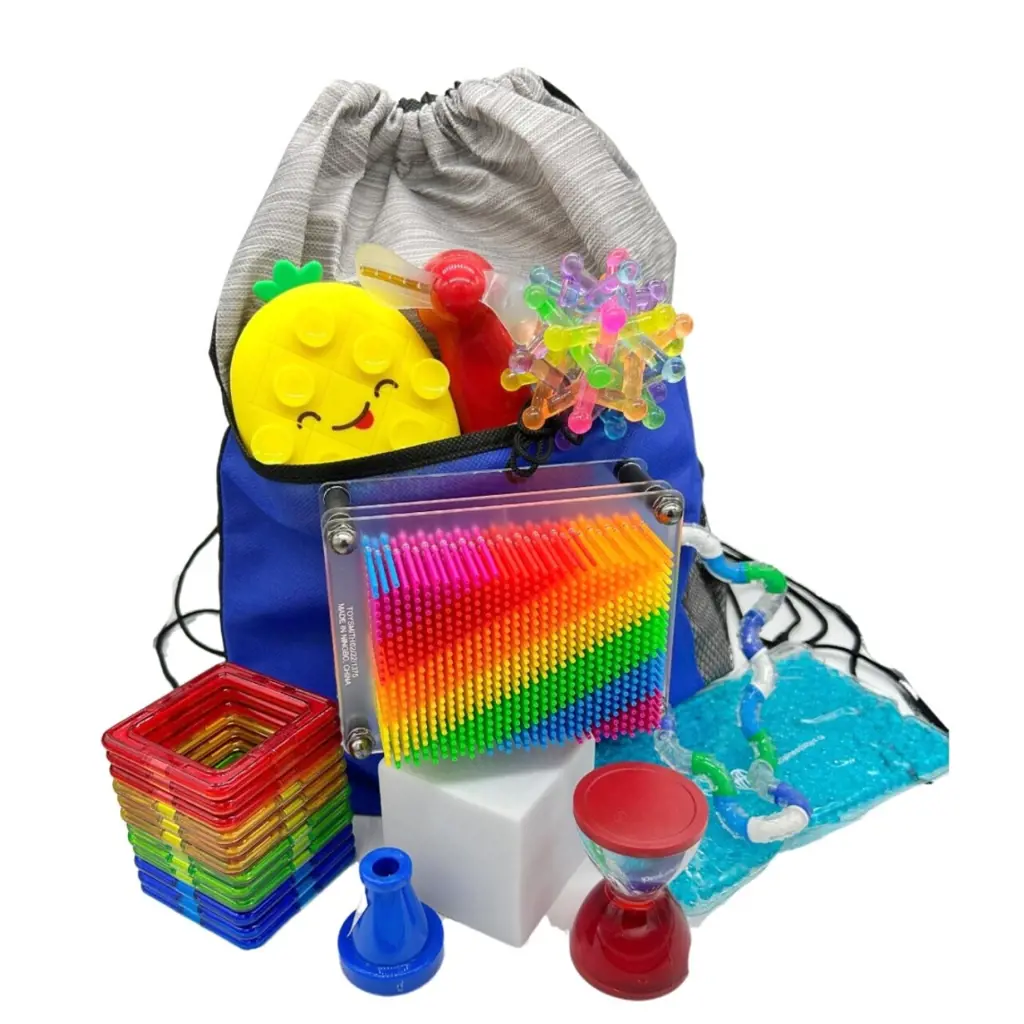
Having a sensory kit for your child with autism can be incredibly helpful in managing their sensory needs while on the go. Every child with autism is unique, and their sensory preferences may vary greatly. Therefore, customizing a sensory kit based on their individual needs is crucial for its effectiveness. Here are some steps you can follow to create a personalized sensory kit for your child's autism backpack:
Step 1: Observe and assess your child's sensory needs
Observe your child's behaviors and reactions to different sensory experiences. Pay attention to their preferences and aversions to various sensory inputs such as touch, sound, sight, smell, and movement. This will give you insight into what items and strategies might help them regulate their sensory system.
Step 2: Consult with professionals
Seek advice from professionals like occupational therapists, speech therapists, or special education teachers who specialize in working with children with autism. They can provide valuable recommendations on sensory tools and techniques that may benefit your child.
Step 3: Identify calming tools
Based on your observation and professional advice, identify calming tools that your child responds well to. This could include items such as fidget toys, stress balls, weighted blankets, noise-canceling headphones, or visual supports like picture schedules or social stories. Remember, what works for one child may not work for another, so it's essential to customize the kit to your child's specific preferences.
Step 4: Consider sensory input tools
In addition to calming tools, consider including sensory input tools in the kit. These tools provide different types of sensory stimulation and can help your child regulate their sensory system. Some examples include sensory balls, textured toys, chewelry (chewable jewelry), vibrating toys, or a small container with scented putty or playdough. Again, choose items that align with your child's sensory preferences and aversions.
Step 5: Pack the essentials
Once you have identified the specific tools and items that work best for your child, pack them in their autism backpack. Make sure to include items that can be easily accessed and carried around. It's also helpful to label or color-code the items for organization and quick identification.
Step 6: Evaluate and adapt
Periodically evaluate the effectiveness of the sensory kit and make necessary adjustments based on your child's changing needs. As your child grows and develops, their sensory preferences may shift, so it's important to update the kit accordingly.
Remember, no two children with autism are alike, and what works for one child may not work for another. The key is to observe, experiment, and customize the sensory kit to meet your child's individual needs. By doing so, you will provide them with the tools and strategies to better manage their sensory challenges and navigate the world more comfortably.
Essential Items to Pack for Your Trip to Kathmandu
You may want to see also

Are there any specific strategies or tools that should be included in an autism backpack to help with communication and social interaction?
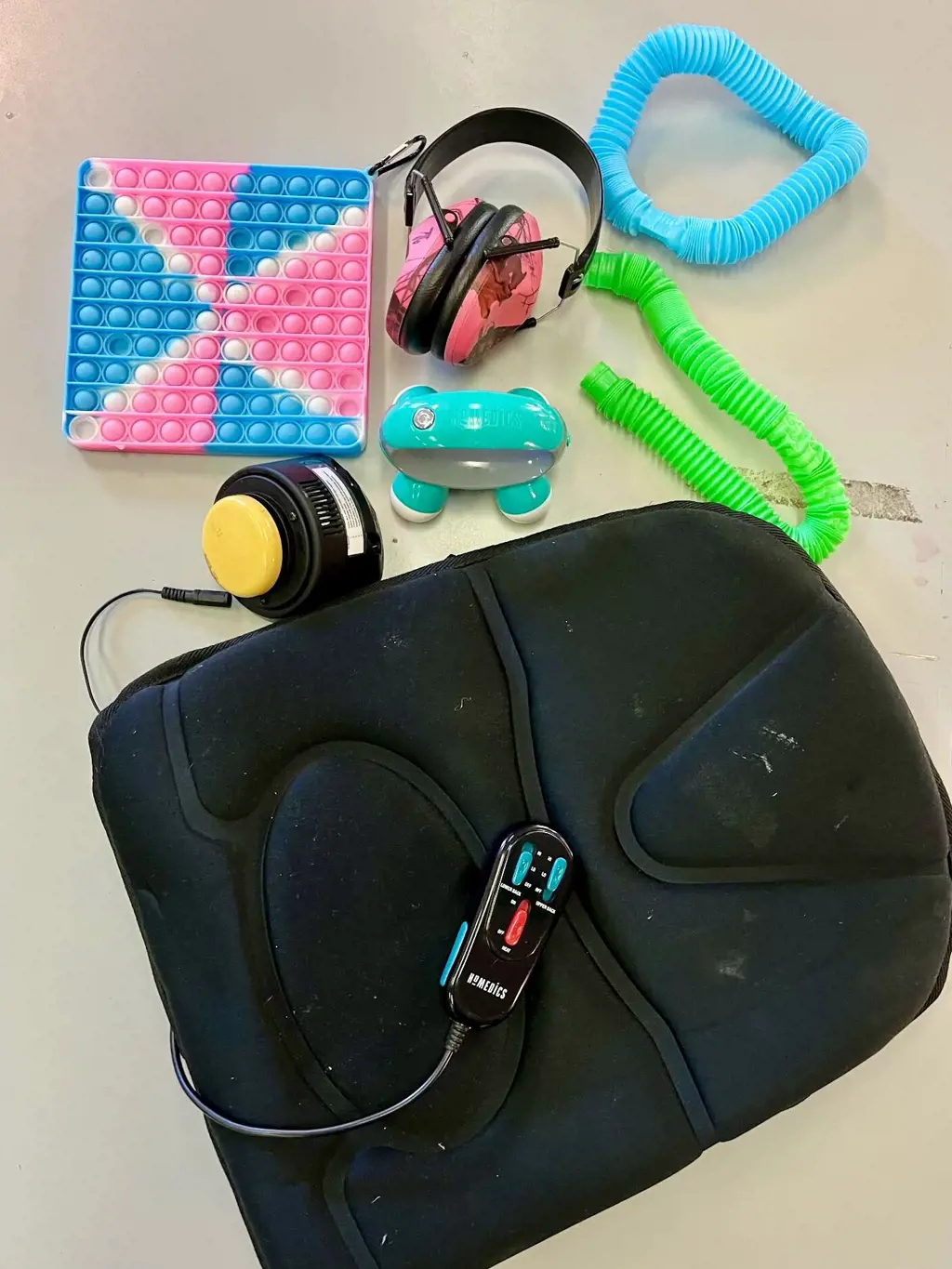
When it comes to supporting individuals with autism spectrum disorder (ASD) in their everyday lives, having the right tools and strategies can make a significant difference. Many individuals with ASD struggle with communication and social interaction, and an autism backpack can be a helpful resource for addressing these challenges. Here are some specific strategies and tools that can be included in an autism backpack to support communication and social interaction.
- Visual supports: Visual supports are an essential tool for individuals with ASD, as they help to make information more concrete and understandable. Visual supports can include visual schedules, social stories, and communication boards. These visual aids provide visual cues and prompts that aid in comprehension and communication.
- Social scripts: Social scripts are written or visual guides that help individuals with ASD navigate social situations. They provide a step-by-step guide on how to initiate conversations, respond to questions, and engage in appropriate social behaviors. Including social scripts in an autism backpack can help individuals with ASD feel more confident and prepared in social situations.
- Communication aids: Augmentative and alternative communication (AAC) tools can be immensely helpful for individuals with ASD who struggle with verbal communication. Including AAC devices, such as communication apps, picture exchange communication system (PECS), or communication boards, in an autism backpack can provide individuals with a means to express themselves effectively.
- Fidget tools: Many individuals with ASD benefit from fidget tools, as they can help them maintain focus and reduce anxiety in social situations. Fidget tools can include stress balls, fidget spinners, or textured objects. Including a variety of fidget tools in an autism backpack allows individuals with ASD to choose the tool that works best for them.
- Social skills games: Including social skills games in an autism backpack can be an enjoyable way for individuals with ASD to practice and improve their social interaction skills. Games that focus on turn-taking, sharing, or perspective-taking can help individuals with ASD learn and reinforce important social skills in a fun and engaging manner.
- Noise-canceling headphones: Individuals with ASD can be highly sensitive to noise, which can be overwhelming in social environments. Including noise-canceling headphones in an autism backpack can provide individuals with a way to minimize sensory overload and maintain focus in social situations.
- Emotion cards: Emotion cards are visual aids that help individuals with ASD recognize and understand different emotions. Including emotion cards in an autism backpack can support individuals with ASD in identifying and expressing their own emotions, as well as understanding the emotions of others.
It's important to note that each individual with ASD is unique, and not all strategies and tools will be effective for everyone. It's essential to tailor the contents of an autism backpack to the specific needs and preferences of the individual. Working closely with professionals, such as speech-language pathologists or occupational therapists, can help identify the most beneficial strategies and tools for inclusion.
In conclusion, an autism backpack can be a valuable resource for individuals with ASD, particularly in supporting communication and social interaction. Including visual supports, social scripts, communication aids, fidget tools, social skills games, noise-canceling headphones, and emotion cards can provide individuals with the necessary support and tools to navigate social situations more effectively. By personalizing the contents of an autism backpack to meet the unique needs of the individual, individuals with ASD can develop essential communication and social interaction skills.
Essential Items to Pack for College Life in New York
You may want to see also

What should I consider when choosing a backpack for my child with autism?
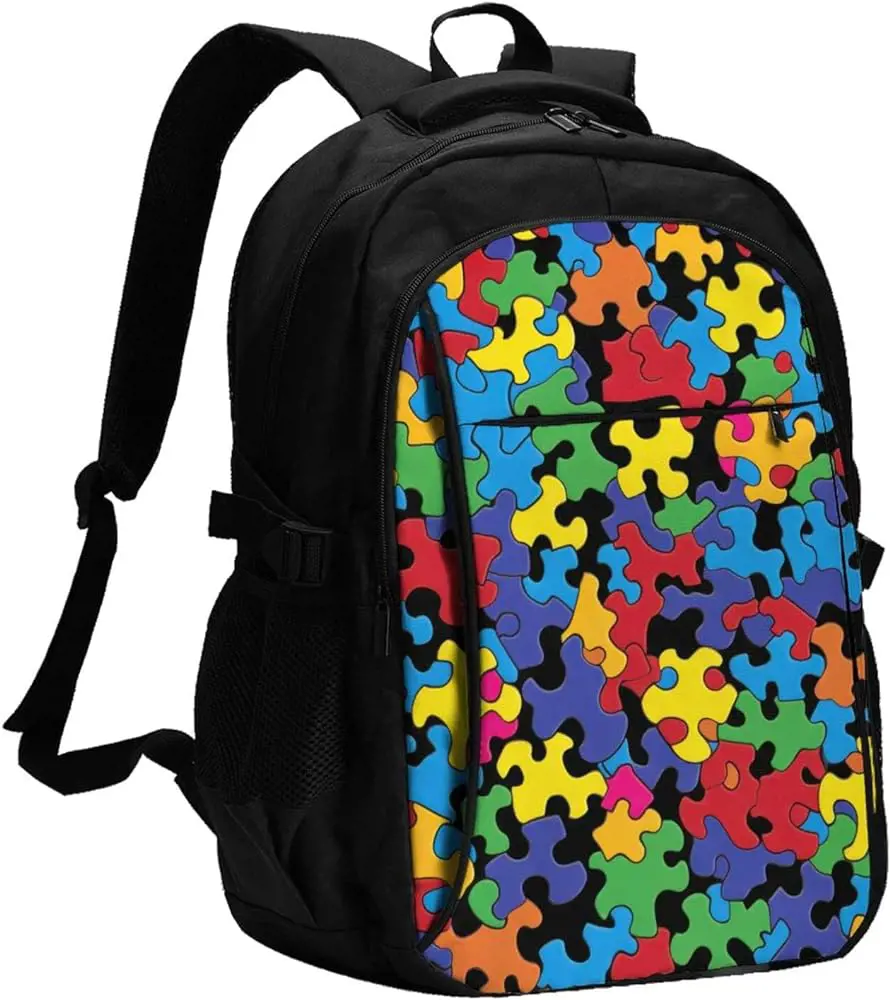
When choosing a backpack for a child with autism, there are several key factors to consider. This is because individuals with autism often have sensory sensitivities and may require additional support to meet their specific needs. By taking these factors into account, you can help ensure that your child's backpack is comfortable and supportive, and promotes their independence and well-being.
Sensory Considerations:
Children with autism may have sensory sensitivities, so it is important to consider the texture, weight, and design of the backpack. Look for backpacks made from soft materials like nylon or cotton, which are less likely to cause discomfort or irritation. Avoid backpacks with rough or scratchy fabrics. Additionally, consider the weight of the backpack. Some children may struggle with heavy backpacks, so choose a lightweight option that can still accommodate their belongings.
Comfort and Support:
It is crucial to choose a backpack that provides adequate support and comfort. Look for backpacks with padded shoulder straps and a padded back panel to distribute the weight evenly and reduce pressure on the child's shoulders and back. Adjustable straps are also beneficial as they allow for a customized fit. A backpack with a chest strap or waist belt can provide additional support and stability for children who may have motor coordination difficulties.
Functional Design:
Consider the design and functionality of the backpack. Opt for a backpack with multiple compartments or pockets, as this can help your child stay organized and easily find their belongings. It is beneficial to have separate compartments for heavier items such as textbooks, and smaller pockets for items like pens or a cell phone. Additionally, choose a backpack with easy-to-use zippers or Velcro closures, as children with autism may have fine motor skill challenges.
Safety Features:
Safety should be a top priority when selecting a backpack for a child with autism. Look for backpacks with reflective materials or built-in reflective strips, especially if your child will be walking or cycling to school. These features can enhance visibility, especially during early morning or late afternoon hours. Additionally, choose a backpack with sturdy and durable construction to ensure it can withstand daily use.
Personal Preferences:
Involve your child in the decision-making process to ensure they feel comfortable and empowered. Allow them to choose a backpack in their favorite color or with their favorite character. By incorporating their personal preferences, you can increase their motivation to use and take responsibility for their backpack.
Example:
Sarah, a 9-year-old girl with autism, struggled with wearing a backpack to school. The rough texture of her previous backpack caused discomfort and sensory overload, leading to increased meltdowns. Sarah's mother, Lisa, decided to take a step back and consider Sarah's specific needs.
After researching and considering the sensory sensitivities of individuals with autism, Lisa purchased a soft cotton backpack with padded shoulder straps and a padded back panel. She chose a backpack with multiple compartments to help Sarah stay organized. By involving Sarah in the decision-making process, Lisa allowed her to choose a backpack in her favorite color, which featured her favorite cartoon character.
The new backpack made a significant difference in Sarah's daily routine. It provided the necessary support and comfort, reducing her sensory overload and meltdowns. Moreover, Sarah felt proud and excited to wear her backpack, helping her to develop a sense of independence and responsibility. The careful consideration of sensory needs, comfort, functionality, safety features, and personal preferences made all the difference in finding the perfect backpack for Sarah.
Essential Items to Pack for a Mont Blanc Adventure
You may want to see also

Are there any recommended resources or online stores where I can purchase pre-made autism backpacks or sensory kits?
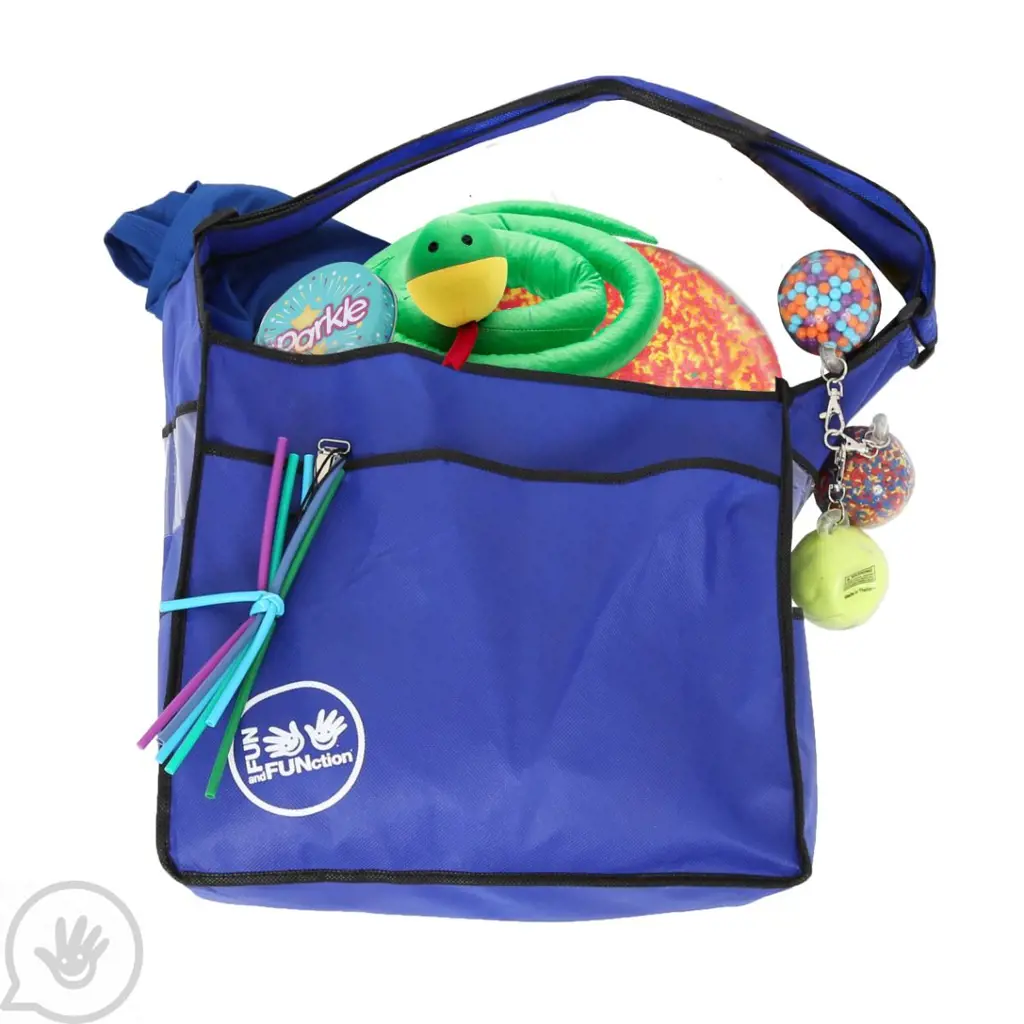
If you are looking to purchase pre-made autism backpacks or sensory kits, there are a variety of resources and online stores available that cater to individuals on the autism spectrum. These backpacks and kits are specifically designed to provide sensory support and comfort to those with autism.
One highly recommended resource is the Autism Toy Store, an online store that offers a wide range of products specifically designed for individuals with autism. They offer pre-made autism backpacks and sensory kits that include a variety of sensory toys and tools to help individuals manage sensory overload and promote self-regulation. The Autism Toy Store provides detailed descriptions and reviews for each product, making it easier for you to choose the most appropriate backpack or kit for your needs.
Another trusted resource is the Sensory TheraPLAY Box, a subscription box service that delivers a curated selection of sensory toys and tools to your doorstep every month. While not specifically offering pre-made autism backpacks, the Sensory TheraPLAY Box provides a convenient way to receive a variety of sensory items that can be used to create your own sensory kit. Each box includes sensory items such as fidget toys, tactile stimulators, and calming aids, all of which can be easily stored in a backpack or bag of your choice.
In addition to specific autism-focused resources, you can also find pre-made autism backpacks and sensory kits on popular online marketplaces such as Amazon. These marketplaces offer a wide range of options from various sellers, allowing you to compare different products and choose the one that best suits your needs and budget. When purchasing from online marketplaces, be sure to read customer reviews and product descriptions carefully to ensure that the backpack or sensory kit meets your requirements.
It's important to note that while pre-made autism backpacks and sensory kits can be a convenient option, you can also create your own customized sensory kit by purchasing individual sensory items separately. This allows you to tailor the kit to your specific needs and preferences. Many autism-focused resources and online stores offer a wide range of individual sensory items that can be purchased separately, giving you the flexibility to create a personalized sensory kit.
Overall, there are several recommended resources and online stores where you can purchase pre-made autism backpacks or sensory kits. Whether you choose a pre-made option or create your own kit, these resources provide a variety of sensory toys and tools to support individuals with autism in managing sensory overload and promoting self-regulation.
Family Reunion Packing Checklist: Essentials for a Memorable Gathering
You may want to see also
Frequently asked questions
In an autism backpack, it is important to include items that help promote sensory regulation, communication, and comfort. These may include fidget toys, noise-cancelling headphones, a weighted blanket or lap pad, visual schedules or social stories, comfort items such as a stuffed animal or favorite blanket, and communication tools such as a picture exchange communication system (PECS) or a communication app on a tablet or smartphone.
Fidget toys can be helpful for individuals with autism as they provide sensory input and help promote self-regulation. These toys can help keep hands busy and provide a source of comfort and focus, reducing anxiety and restlessness. Fidget toys can also be a helpful tool for individuals who struggle with attention or have difficulties sitting still for long periods of time.
Noise-cancelling headphones are headphones that reduce or cancel out background noise. These headphones are recommended for an autism backpack because they can help individuals with autism who may be sensitive to loud noises. The headphones can help create a quieter and more calming environment, reducing sensory overload or distress in certain situations such as crowded or noisy places.
Visual schedules and social stories are visual supports that can help individuals with autism understand and navigate daily routines, expectations, and social situations. These visual tools provide a visual representation of what will happen, making the information easier to process and understand. Visual schedules can help individuals with autism feel more organized, reduce anxiety, and create predictability in their daily lives. Social stories specifically help individuals with autism understand and prepare for social situations by providing a step-by-step narrative with visuals to explain expectations, social cues, and appropriate behavior.
A picture exchange communication system (PECS) is a form of augmentative and alternative communication (AAC) that uses pictures or symbols to help individuals with autism communicate their needs, wants, and thoughts. Including PECS in an autism backpack can be helpful for individuals who have difficulty with verbal communication. These communication tools provide a way for individuals to express themselves and communicate effectively, even in situations where verbal communication may be challenging.







